Listening for design
Architect Ian Bogle always has an ear open for any conversation about learning: listening with understanding to a client can then set a new design apart.
The education debate and school design
I’ve just returned from the GESS Conference in Dubai which, as ever, was very focused on the future of education and schools. The debates ranged from conversations about the physical environments of future school designs to the acceptable use of AI as a learning tool.
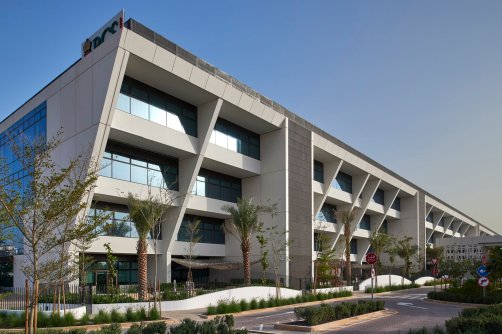
The panel I was asked to be part of was specifically about designing sustainable schools, but for an architect a conference like this is a great listening opportunity as well as a chance to make a contribution as a speaker. The regional project that Bogle Architects had recently been part of was the design and build of the new Royal Grammar School Guildford, Dubai, an innovative K-12 School located at Tilal Al Ghaf to the Southeast of the City. It is now in its third year of operation: having opened with 250 pupils, it now accommodates 1,250 students as it heads towards capacity of 2,100.
Spaces to serve a vision
It is of course our job to design an environment that makes world class teaching possible, but when a design ‘clicks’ with a client’s vision, things can really take off and set a school apart. It was therefore important to listen carefully to the different people on the client team, both from Cognita, the school’s owners and their educational partners at the Royal Grammar School, Guildford. From the very outset, as well as the requirement for 2,100 children, the brief from Cognita, was to deliver the most sustainable School in the Middle East while providing spaces that would facilitate the ‘Wellbeing’ agenda of RGS Guildford.
A further point from the RGSG side of the Client team was for the new school to be able to implement the policy of peer mentoring, whereby each pupil has an older ‘buddy’ to guide them through the years. Our design had to provide spaces that would place this at the centre of the school’s operation.
The final challenge set for the design team was that this contemporary, 21st century school in the desert should hark back both physically and metaphorically to the 15th Century School in Guildford, southwest of London – keep reading!
Design response
The initial design response was to tackle the issue of the building’s location and climatic challenges and specifically the sun. However, while the sun poses difficulties in making buildings overheat it is also a pretty reliable renewable resource. We therefore embraced the opportunity to balance both the pros and cons of the big orange ball in the sky.
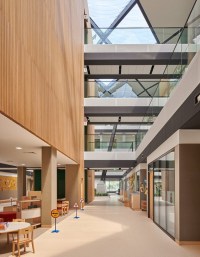 The building’s form is a deliberate act to prevent direct sunlight hitting the windows in this harsh desert environment with its soaring temperatures. The resulting internal space creates a ‘cosy’ ground floor for the younger children which aligned with the KHDA’s (the Knowledge and Human Development Authority – the private school regulator in Dubai) requirement that all children up to the age of 6 should have their principal classroom on the ground floor. At the same time, the expanding atrium space feels more collegiate at the upper floor, anticipating tertiary education for Years 12 and 13 (Grades 11 and 12)
The building’s form is a deliberate act to prevent direct sunlight hitting the windows in this harsh desert environment with its soaring temperatures. The resulting internal space creates a ‘cosy’ ground floor for the younger children which aligned with the KHDA’s (the Knowledge and Human Development Authority – the private school regulator in Dubai) requirement that all children up to the age of 6 should have their principal classroom on the ground floor. At the same time, the expanding atrium space feels more collegiate at the upper floor, anticipating tertiary education for Years 12 and 13 (Grades 11 and 12)
The space also gives the opportunity for the younger children to see the older children and vice versa, engaging them with each other and facilitating the concept of mentoring.
While entirely appropriate from an internal organization perspective the primary reason for the stepping building form allows the floor above to shade the floor below, thus minimizing the overheating effect through sun penetration and in turn reducing the energy requirements of the building. While an environmental benefit by reducing carbon emissions, it is also a financial benefit in terms of reduced operational costs – a ‘win-win’ situation as they say.
This simple innovative approach to the building’s form also allows for a significant area of photovoltaic (PV) panels to be located on the roofs of the structures, generating significant ‘on-site’ energy and creating a ‘carbon neutral’ school in operation . . . in the desert!
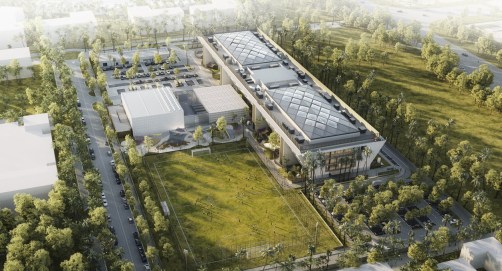
Sustainable and flexible school spaces
Sustainability is not just about energy efficiency: it encompasses a whole range of principles from financial, social and community perspectives while enabling students to work together in a wide variety of different ways. And the conversations I was listening to showed that variety is important.
So, while classrooms and exams have their place, there lies the ability to do more collaborative and project-based activities in spaces within buildings that would otherwise not be used. I’ve often said no-one has an idea at their desk whether at school or in the ‘grown-up’ world. Ideas are created by groups in informal settings.
International School in Ho Chi Minh City
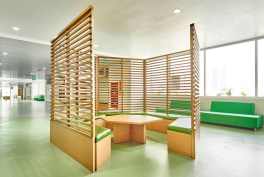 At the International School in Ho Chi Minh City senior school, for example, the notion of using the corridor space for learning activities has been embraced by both teachers and pupils.
At the International School in Ho Chi Minh City senior school, for example, the notion of using the corridor space for learning activities has been embraced by both teachers and pupils.
Our design deliberately created a wider corridor, activated with natural light, which could and is being used for informal learning. Smaller ‘group-based’ activities break out into the corridors giving the children freedom to create and communicate between themselves.
In this context, ‘biophilia’ has also become an important design concept. This is not only about greening spaces (see ITM ‘Outside in’), but is also about the quality of natural light within spaces. This connection with nature simply not only makes us feel better, it also makes us more productive. In all our school designs we effectively try and ‘design-out’ the artificially lit corridor and ISHCMC benefits massively by having an ‘active’, naturally lit connecting spaces.
All buildings need circulation space, but the trick is to make it work harder and become usable beyond its primary objective – moving from one space to another. It’s worth researching recent schools in Finland that too adopt this principle – effectively having rooms without walls. So, using the circulation space is fundamental to progressive education design.
Back to the future
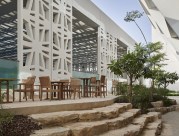
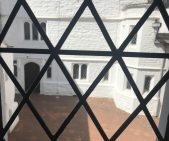 Returning to Dubai, in conclusion, the large atrium space also provides informal break-out spaces for less directed activities but if you look closely and squint, the large daylight canopies could be interpreted as a close representation of the leaded windows of the 15th Century school in Guildford – contemporary yet deliberately and sympathetically referencing the past.
Returning to Dubai, in conclusion, the large atrium space also provides informal break-out spaces for less directed activities but if you look closely and squint, the large daylight canopies could be interpreted as a close representation of the leaded windows of the 15th Century school in Guildford – contemporary yet deliberately and sympathetically referencing the past.
Another part of our Design Brief.
 Ian Bogle – Founder and Creative Director
Ian Bogle – Founder and Creative Director
Bogle Architects, London, December 2023.
All images with kind permission from Bogle Architects.
Recognition for Royal Grammar School Guildford Dubai:
- Foreign Construction of the Year, Stavba Roku 2021 – Winner
- Big Project Middle East Awards 2021 – Energy Project of the Year
- Best Architecture Environment, Design and Sustainability in a UAE School 2021-22 – Winner
For more about Ian’s ideas, see:

